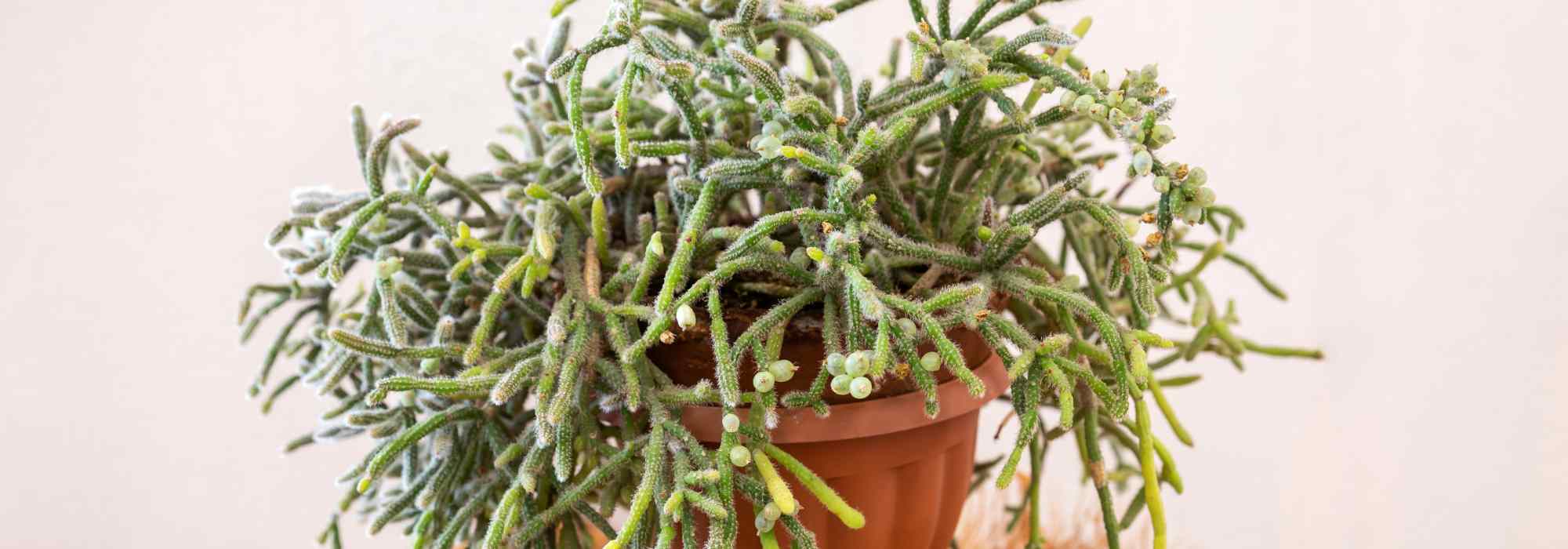
Rhipsalis - Mistletoe cactus : planting and care for this trailing indoor cactus
Contents
The Rhipsalis in a nutshell
- It charms with its soft, trailing habit and its graphic stems.
- Low-maintenance, the Rhipsalis cactus is one of the easiest to grow indoors.
- Taking a cutting from Rhipsalis is child’s play, in spring or summer.
- Undemanding, it particularly dislikes excess water and cold draughts.
- Unique, it fits perfectly into bright interiors, in pots or hanging baskets.
The word from our expert
The Rhipsalis, also known as “mistletoe cactus”, “reed cactus”, or “coral cactus” depending on the species, is an ideal houseplant for adding a light and original botanical touch to your décor. Originating from the tropical forests of South America and Africa, this atypical cactus grows as an epiphyte on trees, giving it a flexible, trailing habit with slender, graphic stems. In our homes, species like Rhipsalis paradoxa, with its uniquely segmented habit, or Rhipsalis baccifera, highly prized for its ease of cultivation, fit effortlessly into bright spaces, whether in pots or hanging baskets. While the flower of Rhipsalis is subtle, its flowering is nonetheless charming, especially in the heart of winter.
In terms of care, the Rhipsalis is undemanding: moderate watering, allowing the surface of the soil to dry out between waterings, is more than sufficient. Easy to grow, it thrives in bright, indirect light and well-draining soil. It only dislikes cold and overwatering. It propagates easily through stem cuttings. Taking cuttings from Rhipsalis baccifera, for example, is one of the most common ways to propagate it: simply cut a segment, let it dry for a few days, then replant it in a well-draining mix, allowing you to create new potted plants or share them with loved ones.
Easy-going and strikingly graphic, adopt the Rhipsalis, this epiphytic cactus, in a hanging basket or pot!
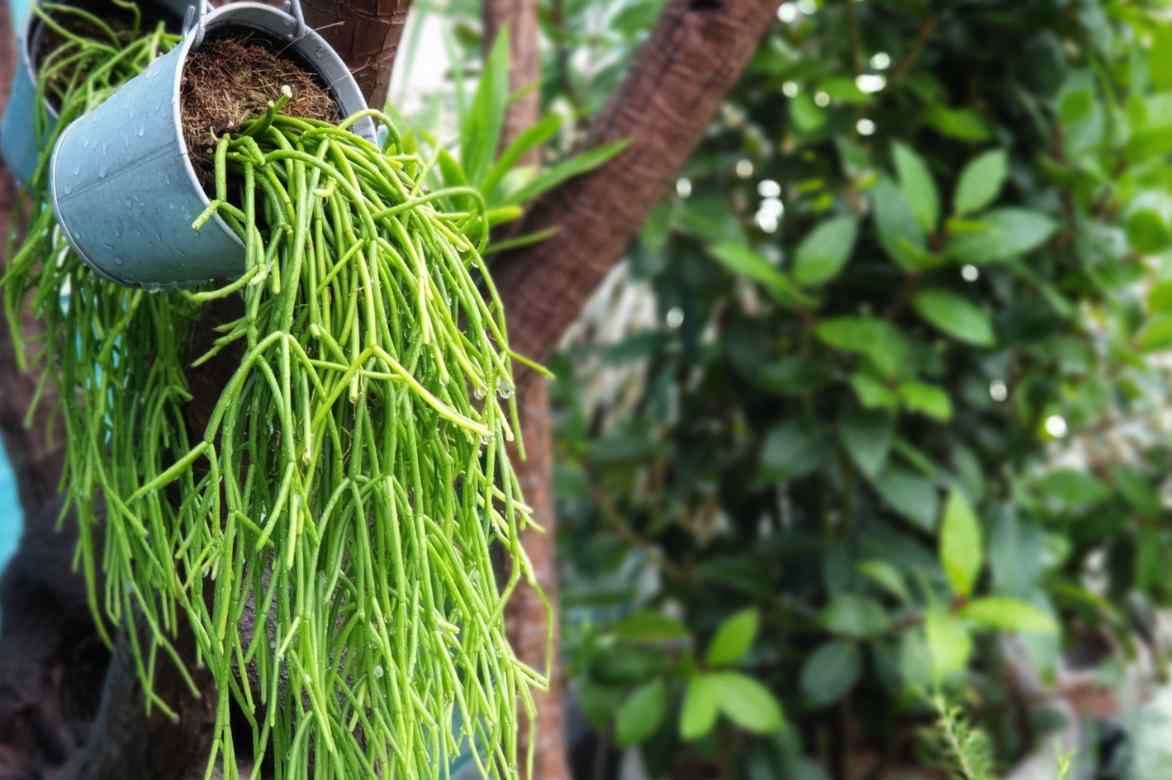
The mistletoe cactus, an original to grow indoors
Botany and description
Botanical data
- Latin name Rhipsalis
- Family Cactaceae
- Common name Mistletoe cactus, coral cactus
- Flowering small star-shaped flowers, white or cream (late winter to spring)
- Height Between 30 cm to 1 m
- Exposure Bright
- Soil type Slightly acidic, very well-draining
- Hardiness Frost-sensitive
The Rhipsalis is a cactus belonging to the Cactaceae family, a group of plants mostly adapted to arid environments. However, the Rhipsalis stands out from the majority of its cactus cousins: it is indeed an epiphytic cactus that lives in humid tropical forests, a rare trait among Cactaceae. It is found in Central and South America, as well as in tropical Africa, Sri Lanka, and Madagascar. The genus name Rhipsalis comes from the Greek rhips, meaning “wicker” or “flexible branch”, referring to its thin, trailing, and often ramified stems. The Rhipsalis is a succulent in the botanical sense, but with very different needs from desert succulents: more ambient humidity, no direct sunlight, and a very well-draining but slightly cooler substrate.

Rhipsalis houlletiana and Rhipsalis oblonga (botanical plates circa 1920)
It is also known by the names “mistletoe cactus”, “reed cactus” or even “coral cactus”, popular names directly inspired by its appearance. The nickname “mistletoe cactus” refers to the small white and translucent berries produced by some species, such as Rhipsalis baccifera, which resemble the fruits of traditional mistletoe. As for the name coral cactus, it evokes the segmented and rounded shape of some stems, particularly in Rhipsalis cereuscula, whose appearance may resemble soft coral branches, swaying gently.
In nature, it grows clinging to tree branches, enjoying the filtered light of the canopy, often in warm and very humid environments. This plant is widely cultivated indoors, as it cannot tolerate cold: it is frost-sensitive and has very low hardiness, not tolerating temperatures below 12-15°C. Its need for constant warmth makes it an ideal indoor plant in our temperate climates.
The genus Rhipsalis includes between 35 and 40 botanical species, all native to humid tropical regions. They are distinguished by their flexible stems, usually trailing or twisted, and their lack of prominent thorns, making them very different from desert cacti. Among the most frequently cultivated indoors are:
- Rhipsalis baccifera, commonly referred to as the “mistletoe cactus”, is the most widespread. Its long, thin, trailing cylindrical stems form an original plant curtain. It produces small translucent white berries, similar to those of mistletoe, which earned it its nickname.
- Rhipsalis cassutha is also nicknamed “mistletoe cactus”, although it is sometimes confused with R. capilliformis. It is characterised by its very fine and abundantly ramified stems, creating a hairy effect.
- Rhipsalis cereuscula, called “coral cactus”, features rounded, segmented, and bright green stems. Its discreet flowering offers greenish-white flowers. This species can reach 40 cm in length and spread, ideal for a graphic effect in a hanging pot.
- Rhipsalis crispata stands out with its flattened stems with serrated edges, giving it a sculptural appearance. It produces small cream flowers at the junction of the segments. It can reach 60 cm in length and 40 cm in spread.
- Rhipsalis pilocarpa is less common but highly prized for its thick stems covered in white, silky hairs. It offers very fragrant cream-white flowers, a particularly rare trait among cacti, making it a favourite among collectors.
- Rhipsalis paradoxa is known for its flat and imbricate stems, forming very decorative segmented chains. This unusual habit gives it a graphic, almost geometric silhouette.
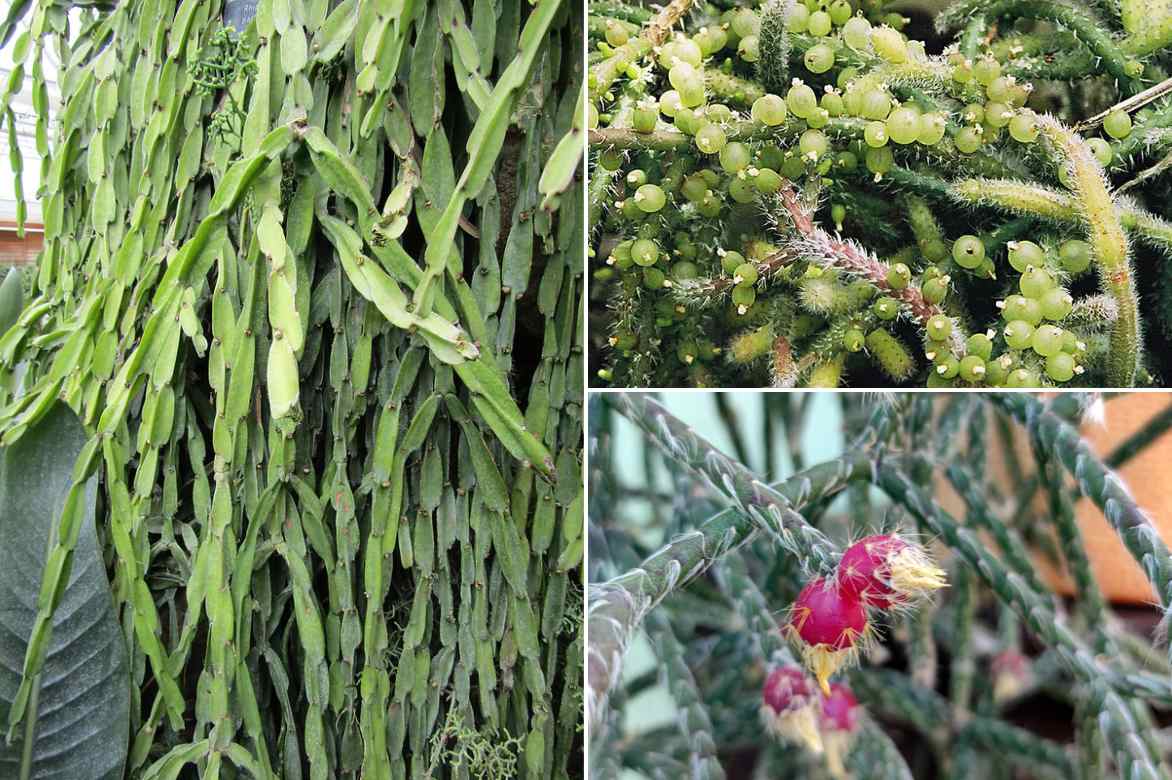
Rhipsalis paradoxa on the left (©Leonora Enking), Rhipsalis baccifera top right and Rhipsalis pilocarpa bottom right
Rhipsalis has a flexible and trailing habit, typical of epiphytic plants. It develops without a true trunk, but from segmented or cylindrical main stems that branch abundantly, forming dense cascades of foliage. Its root system is shallow, adapted to an epiphytic life, often anchored in a light substrate or directly on tree bark in its natural habitat. The roots are fine, few in number, but effective for anchoring and absorption in a humid environment.
Rhipsalis does not grow upright like a vertical plant but develops mainly in trailing stems. Depending on the species, its stems can reach 30 to 100 cm in length, or even more in well-established cultivation. In a hanging pot, it often forms a dense and flexible cascade of foliage. Its spread can also vary: some species spread widely, up to 40 to 60 cm in diameter, depending on stem density and growing conditions.
The foliage is actually reduced or non-existent: the stems themselves carry out photosynthesis. The surface of these stems is smooth or finely velvety, depending on the species, and their random arrangement creates a very aesthetic graphic effect. The stems, which vary greatly between species, can be thin, thread-like, cylindrical, or flattened, sometimes segmented. They are light to dark green, occasionally slightly translucent, and do not feature spiny areoles like most cacti, but fine hairs or bristles on some species.
Rhipsalis usually flowers between late winter and early spring, depending on growing conditions and the species. The flowering is usually discreet, but charming, with small solitary or clustered flowers emerging directly from the stems. They are white, cream, or slightly greenish, sometimes pinkish, and often have a subtle fragrance. Each Rhipsalis flower, measuring 0.5 to 1 cm in diameter, opens into a star with soft and slightly translucent petals. Flowering is not rare, but it depends heavily on growing conditions. A cool winter rest period (around 12°C), combined with good light and reduced watering, encourages flowering. In continuously heated indoor environments, without seasonal contrast, flowering may be more timid or absent.
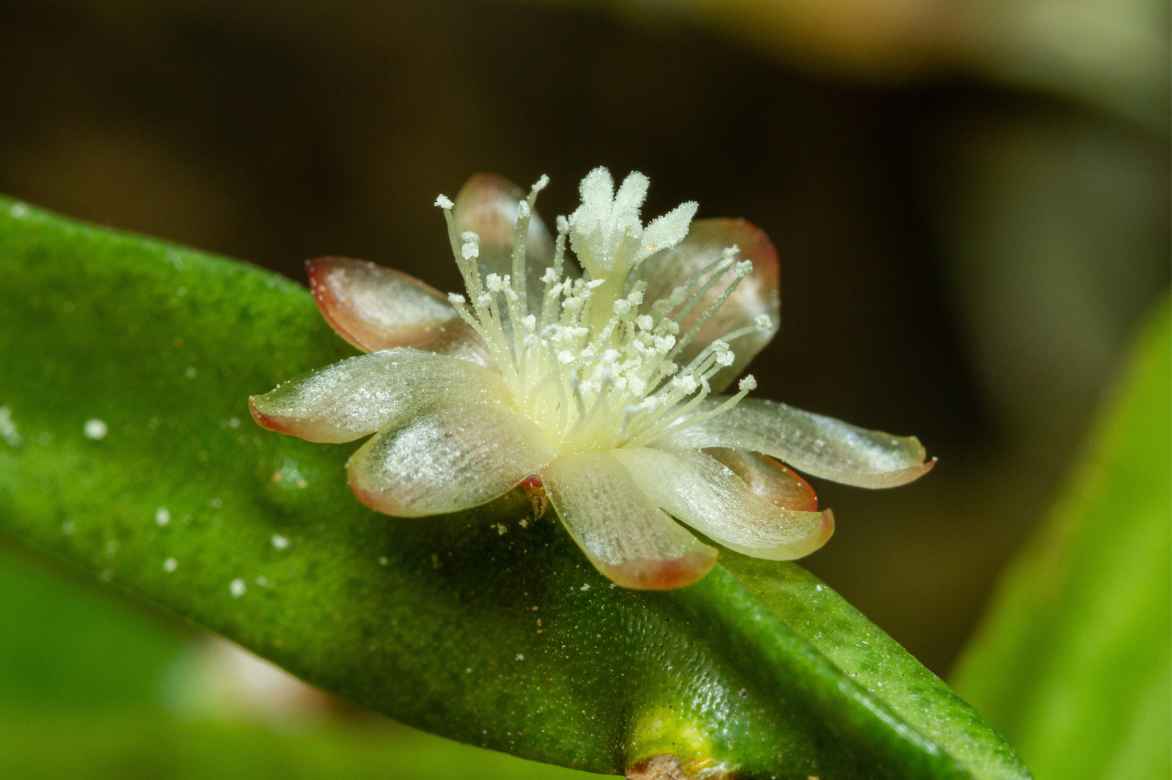
Flowering of Rhipsalis trigona
Fruiting follows quickly after flowering, producing small spherical berries, white to translucent or sometimes slightly pinkish depending on the species. These fruits resemble pearls and persist for a long time on the plant.
Popular varieties
In addition to botanical species, several horticultural varieties of Rhipsalis have been selected for their unique habits, foliage shades, or compactness, making these cacti even more attractive for indoor decoration. These varieties are all suited to indoor cultivation and offer different shapes and textures, ideal for creating hanging displays.
- Rhipsalis baccifera ‘Oasis’: This variety stands out for its slightly thicker stems and particularly dense habit. It quickly forms a very aesthetic cascading plant, perfect for hanging displays.
- Rhipsalis cassutha ‘Hairy’: With even finer stems and accentuated branching, this variety enhances the typical villous effect of the species, giving a very airy and light appearance.
- Rhipsalis cereuscula ‘Coralloides’: Offers a more compact habit and growth in small segmented bushes reminiscent of corals. It is highly prized for its rounded silhouette and permanent decorative appeal.
- Rhipsalis ewaldiana: A variety with fine, trailing stems, but longer than those of cassutha, featuring a soft green hue and abundant flowering. Less well-known, it deserves to be discovered.
- Rhipsalis elliptica: A striking form with flattened stems, almost ribbon-like, with a slightly veined texture. Perfect for adding an exotic and graphic touch to a contemporary interior.
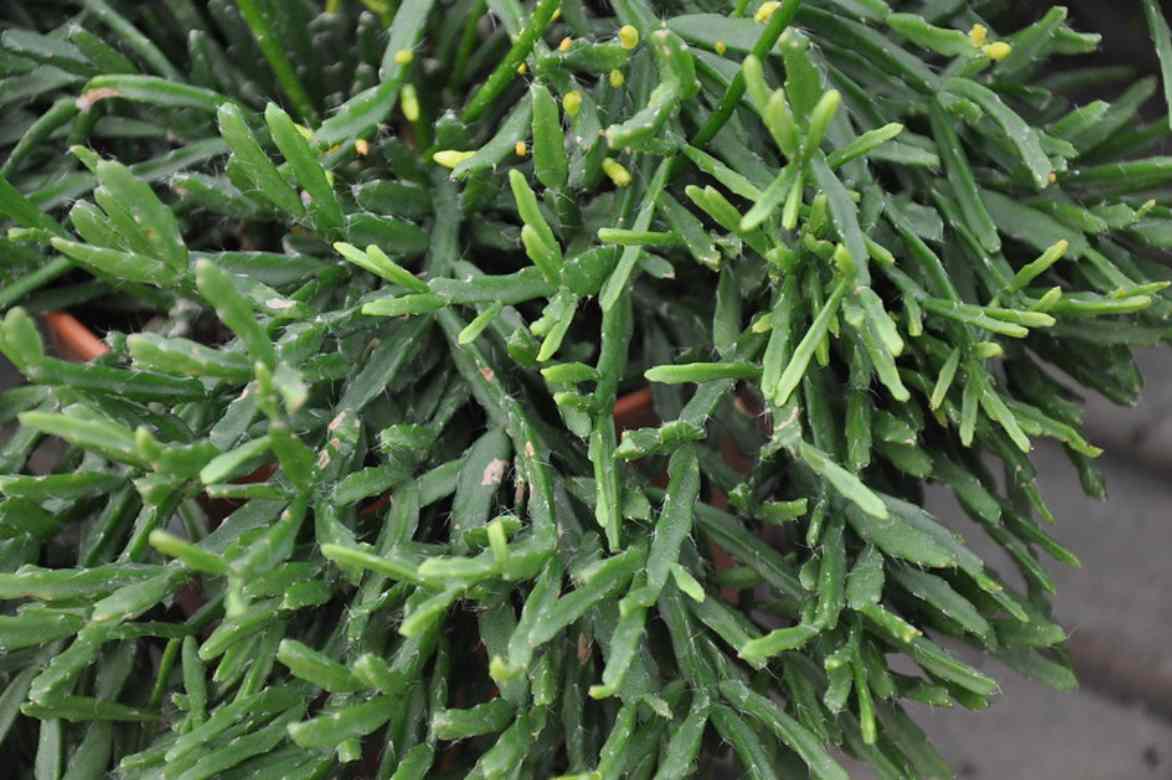
Rhipsalis ewaldiana (© Stefano)
Planting Rhipsalis in Pots
Where to Place Your Potted Rhipsalis Indoors?
The Rhipsalis thrives in bright, indirect light. The ideal spot is near an east or north-facing window, where it can enjoy the gentle morning sun while being protected from the harsh afternoon light. It can tolerate medium light, but its growth will be slower.
In a home setting, it fits perfectly in naturally bright rooms such as a living room, kitchen, office, or well-lit bathroom, where it will enjoy good conditions without being overexposed to direct sunlight. Avoid placing it in overly dark or dry rooms (like directly above a radiator), as well as cold drafts.
The Rhipsalis prefers stability: gentle light, moderate warmth, and minimal sudden environmental changes. This tropical plant requires warmth and cannot tolerate temperatures below 7°C. Frost is fatal, which is why indoor cultivation is essential in our latitudes. However, a short period of coolness in a bright room, around 12°C, can stimulate more abundant flowering in spring. For the rest of the year, it prefers a stable environment with temperatures above 20°C.
The ideal ambient humidity ranges between 40% and 70%, depending on the species. The Rhipsalis is well-suited to most indoor environments. Misting is unnecessary and even discouraged: it can encourage fungal diseases if air circulation is poor. It’s better to rely on natural ambient humidity and ensure regular room ventilation.
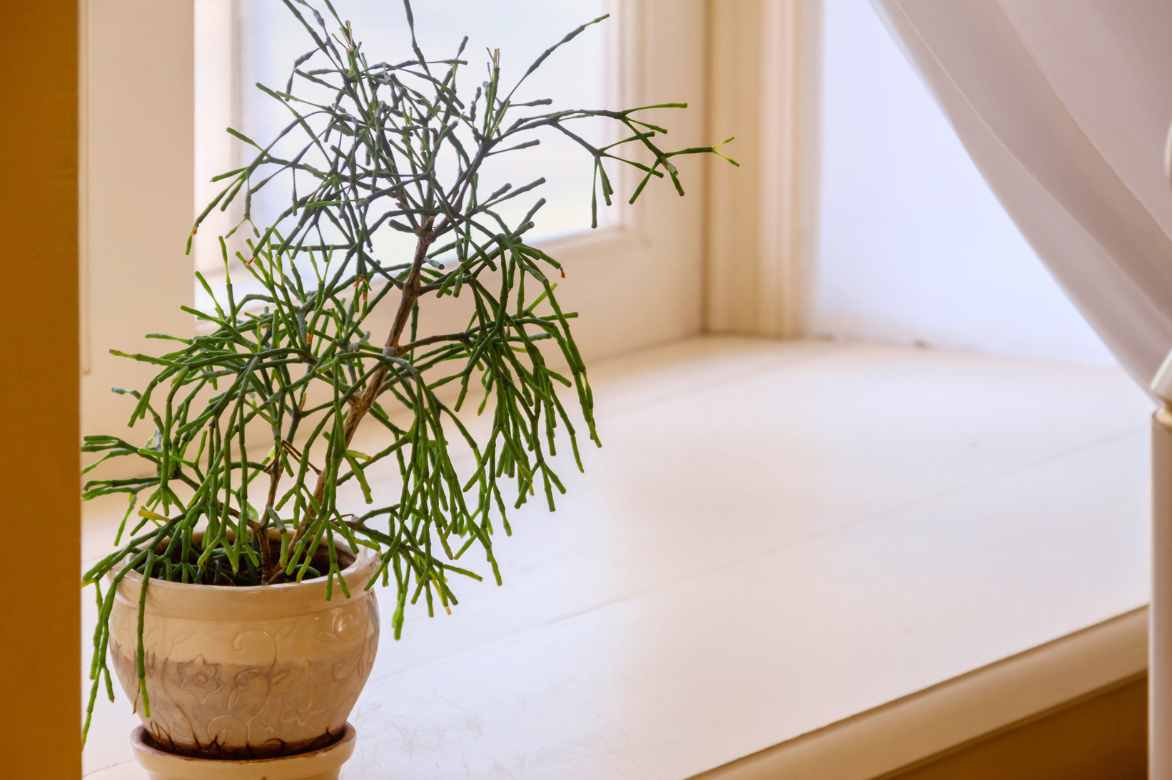
When to Plant a Rhipsalis?
The Rhipsalis can be planted or repotted year-round, as long as indoor growing conditions are stable. However, planting or repotting in spring (from March to June) allows you to take full advantage of the active growth phase to encourage rooting.
The Ideal Substrate
The Rhipsalis needs a very well-draining, light, and airy substrate. You can choose an epiphytic substrate (like orchid mix), composed of bark, perlite, and coconut fibre, or a cactus mix. Regardless of the species, you can easily prepare it yourself. The ideal homemade substrate should remain slightly acidic while ensuring perfect aeration. Mix equal parts of:
- turf, to retain slight moisture while maintaining good lightness;
- special cactus soil, for its well-draining structure, suited to delicate roots;
- perlite or coarse sand to promote aeration and allow quick water drainage.
How to Plant a Rhipsalis in a Pot?
- Use a pot with drainage holes to prevent waterlogging.
- Place a drainage layer at the bottom (clay pebbles or gravel).
- Prepare the mix.
- Gently place the root ball without compacting the roots.
- Fill around with the substrate, leaving the base of the stems exposed.
- Water lightly after planting, then let the surface dry before the next watering.
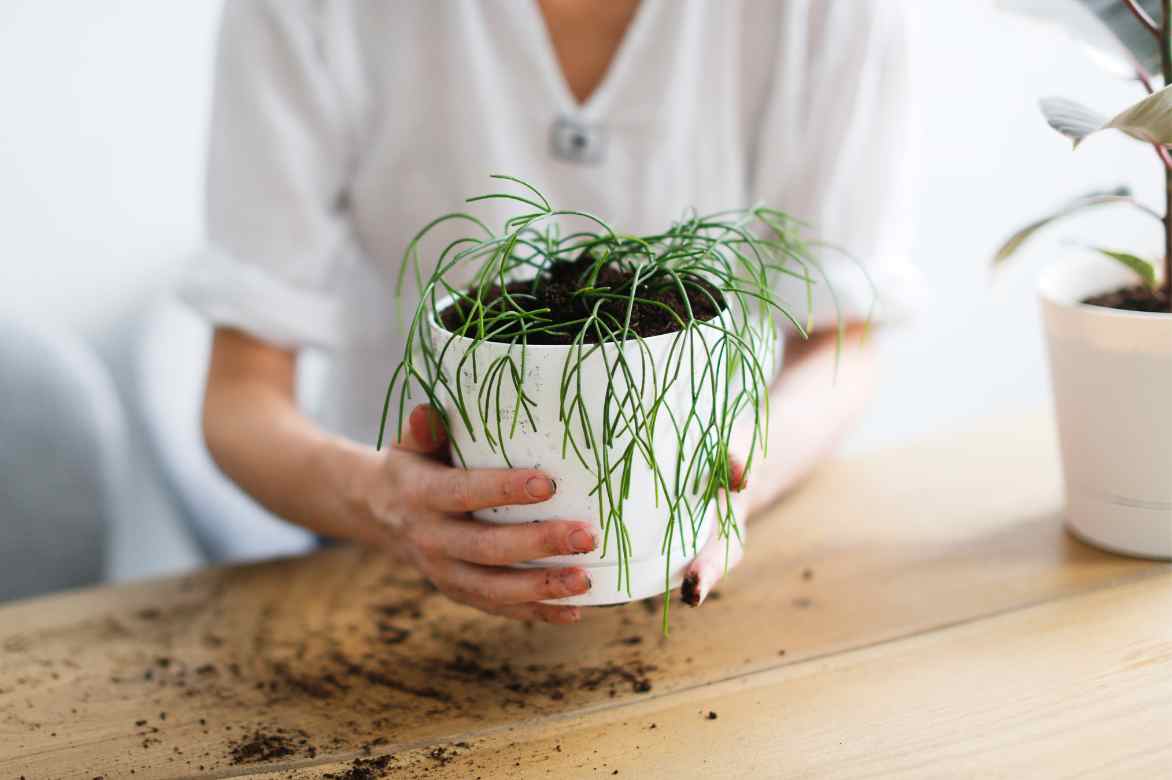
How to care for a Rhipsalis?
Watering
When it comes to watering, it prefers the substrate to dry out on the surface between waterings. Allow the top few centimetres of soil to dry out before watering again. On average, watering every 7 to 10 days during the growth period (spring-summer) is sufficient. In autumn and winter, space it out further: every two to three weeks, depending on the ambient temperature and humidity level. Use water at room temperature, preferably low in lime.
Misting is unnecessary, as previously mentioned, and even discouraged. If the air is too dry, it’s better to slightly increase the ambient humidity by placing the plant near other greenery or on a tray of water and clay pebbles.
Fertiliser
The Rhipsalis is not very demanding, but a light fertilisation can boost its growth. You can provide it with a balanced fertiliser for green plants or cacti, diluted to half strength, once a month between March and September. No fertiliser is needed in winter.
Pruning
Pruning is not essential, but it can be useful to shorten overly long stems or restore a more compact shape to the plant. The plant naturally has a flexible and trailing habit, but some stems may become too long or disrupt the overall silhouette. Pruning is best done in spring or summer, during the growth period.
- Use clean and well-disinfected scissors or pruning shears to avoid any infection.
- Trim overly long or damaged stems, just above a branching point or at the intersection of two segments, depending on the species’ morphology.
- The cut stems can easily be used as cuttings.
Repotting
Repotting is done every 2 to 3 years, preferably in spring. Choose a slightly larger pot and fresh, well-draining substrate. The Rhipsalis likes to be slightly snug, so there’s no need for an overly wide pot. Also, ensure that water never stagnates in the saucer: its fine and sensitive roots dislike excess moisture.
Learn more in our article How to repot a houseplant.
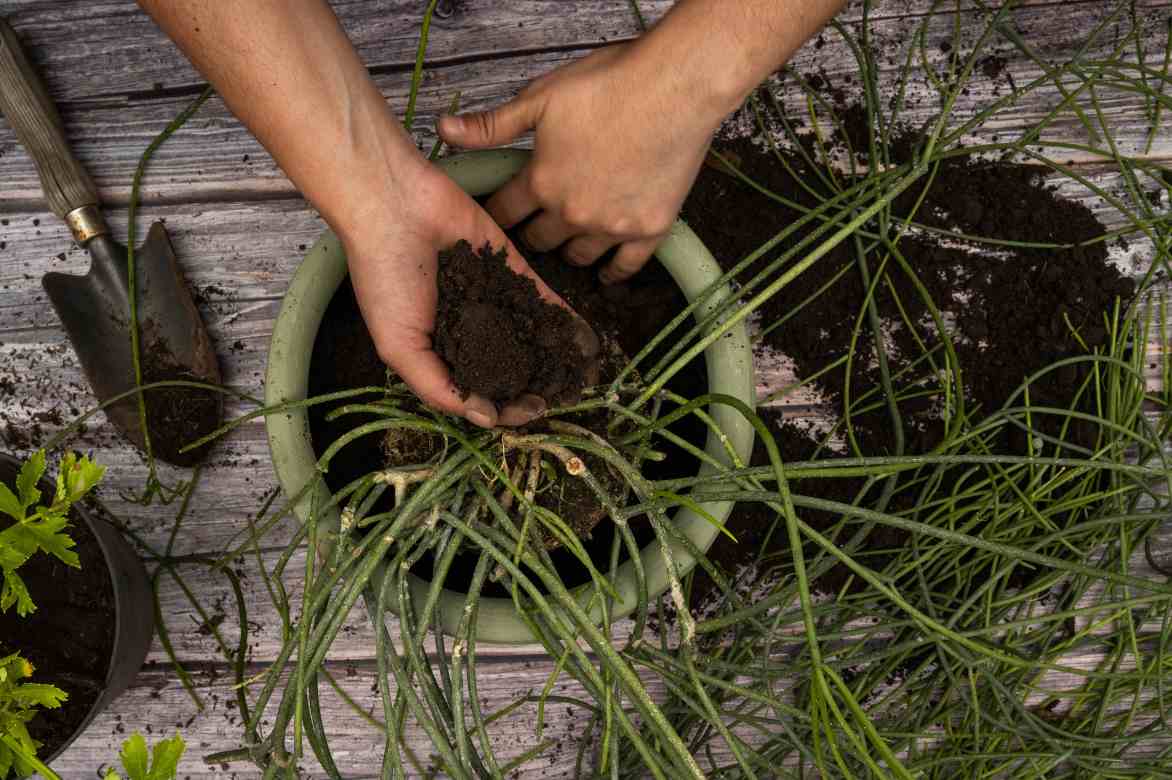
Repot into a pot slightly larger in diameter than the previous one (here a Rhipsalis baccifera)
Diseases and parasitic pests
The Rhipsalis is generally not very prone to diseases or parasitic pests if grown under good conditions. It is a resilient plant, especially if the air is well-ventilated and watering is controlled. However, like all houseplants, it can sometimes be attacked. Here are its most common enemies:
- Mealybugs: They often settle at the base of the stems or in crevices, forming small white cottony clusters. Simply remove them by hand with a cotton pad soaked in 70% alcohol, then spray diluted black soap to eliminate them permanently. To learn more about mealybugs, read our guide Mealybugs: Identification and Natural Treatments.
- Aphids: Less common but possible in cases of high heat and tender growth. They can be eliminated with a garlic decoction or by spraying black soap, repeating the process every 2 to 3 days until they disappear. For more information, read the advice sheet Aphids: Identification and Treatments.
- Red spider mites: In overly dry and hot air, they spin fine webs on the stems. Increase ambient humidity (occasional misting of the surroundings, not the plant) and treat with a natural acaricide or a mixture of water + black soap + vegetable oil. To learn more, read Red Spider Mites: Identification and Treatment
- Root rot: Caused by overwatering or overly compact substrate. Immediately repot, cut away the rotten roots, let the root ball dry for a few hours, then repot in a very well-draining mix with moderate watering.
Good ventilation, moderate watering, and regular checks are usually enough to prevent these issues. Also read our comprehensive guide: Diseases and Parasitic Pests of Indoor Cacti: How to Treat and Prevent Them.
How to take a cutting from a Rhipsalis?
The Rhipsalis propagates very easily by stem cuttings, a simple method you can do at home. The best time to carry out this operation is in spring or summer, during the active growth period, when the plant is most receptive.
Taking a Rhipsalis Cutting
- Take a healthy stem: choose a well-developed, non-flowering stem and cut a segment of about 10 to 15 cm using a clean and disinfected tool.
- Let the cut dry: leave the cutting exposed to air for 2 to 4 days, so the base dries and forms a protective callus. This greatly reduces the risk of rot.
- Plant in a light substrate: place the cutting in a small pot filled with a suitable mix (cactus or epiphyte substrate), lightly moistened. Insert it just enough to keep it upright.
- Place in filtered light: position the pot in a bright spot without direct sunlight, ideal for encouraging rooting.
- Monitor moisture: water very sparingly, only when the substrate becomes dry. Roots usually develop in 3 to 6 weeks. Once the cutting has rooted, you can plant it in its final pot and care for it as an adult plant.
Rhipsalis: How to Incorporate Them Indoors?
With their soft, often trailing habit and airy silhouette, Rhipsalis are perfect indoor plants for a light and contemporary plant decoration. They fit equally well into modern or bohemian settings, or even minimalist interiors where their texture adds depth without visually cluttering the space.
Their naturally trailing structure makes them ideal candidates for hanging pots, high shelves, or furniture edges. In a bookshelf, a desk corner, or suspended in front of a well-oriented window, they create an elegant and soothing “plant cascade” effect. Their slender and graceful habit also allows them to be used in clusters, combining several varieties in pots of different sizes and materials.
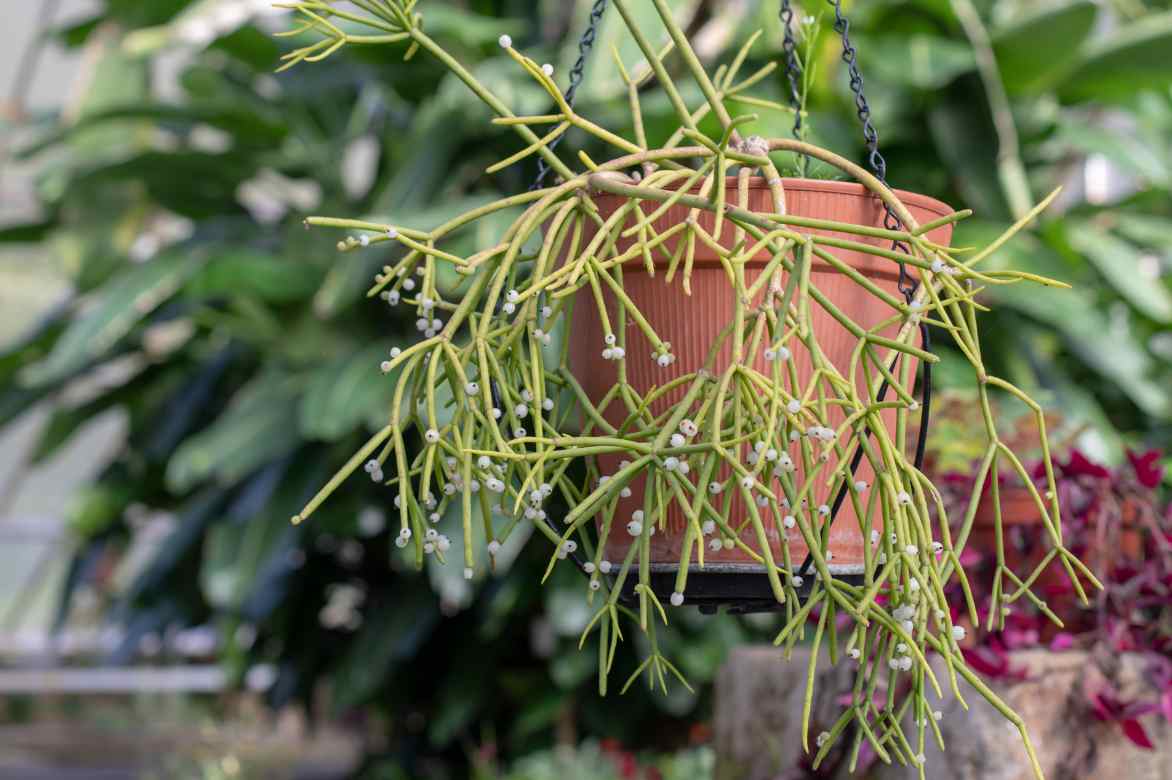
The hanging display particularly highlights the trailing stems of the mistletoe cactus
Adapt the choice of container to your style: a raw stoneware pot for a wabi-sabi vibe, or a vintage macramé for a more natural atmosphere. By pairing them with other indoor green plants featuring fuller or upright foliage, such as a Zamioculcas zamiifolia, a Ficus elastica, or even a Sansevieria, you create an interesting, ultra-graphic plant dynamic.
Thanks to their low-maintenance nature, you can incorporate them anywhere. So, how about starting a collection!?
Also see
→Discover our wide range of houseplants.
→Our decorative foliage houseplants and our flowering houseplants.
→Our numerous books on houseplants
Our article: Indoor Cacti: The Easiest Species to Grow
Frequently asked questions
-
Why is my Rhipsalis turning yellow or losing its stems?
The issue is almost always related to overwatering or poorly drained soil. Despite its tropical appearance, the Rhipsalis is an epiphytic cactus: it doesn't like having its roots in water. If the soil retains too much moisture or if the plant is overwatered, its stems may turn yellow, soften, and eventually fall off. Good drainage, moderate watering, and soft light are the keys to avoiding this problem.
-
Does the Rhipsalis flower?
Yes, the Rhipsalis does flower, but its flowering is often subtle, typically occurring in winter or early spring. The flowers are star-shaped and can be slightly fragrant depending on the species. A cool winter rest, around 12°C, in a bright room can encourage more abundant flowering.
-
Is the Rhipsalis toxic?
No, the Rhipsalis is not toxic, neither to humans nor to pets. It is a safe plant, ideal for households with children or curious animals. Therefore, it can be placed without worry in any room of the house.
- Subscribe!
- Contents
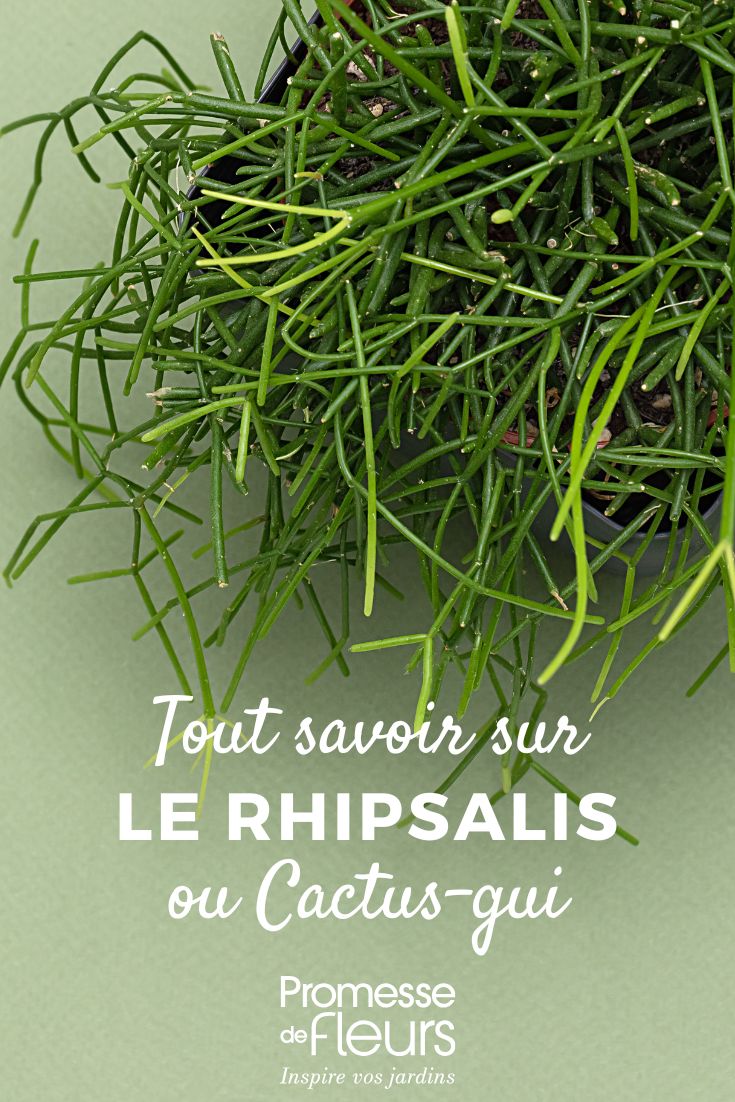































Comments